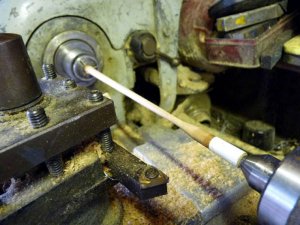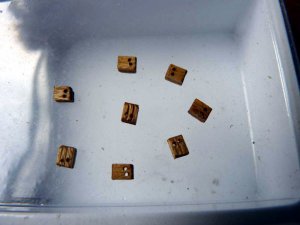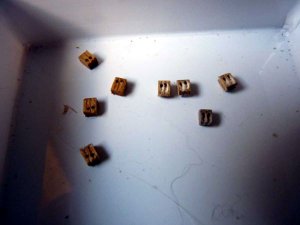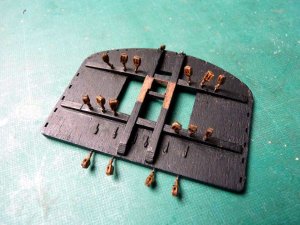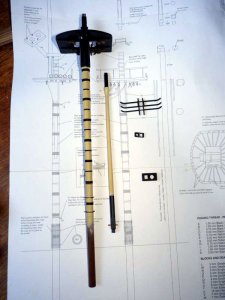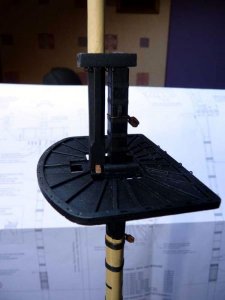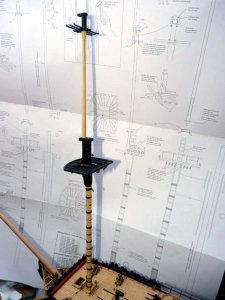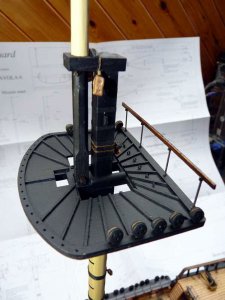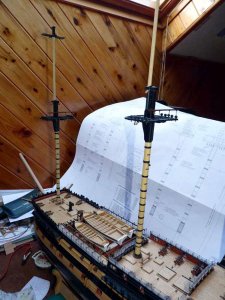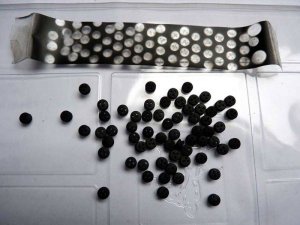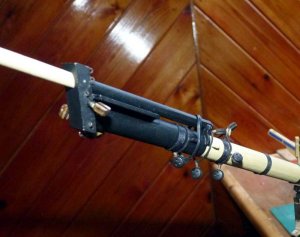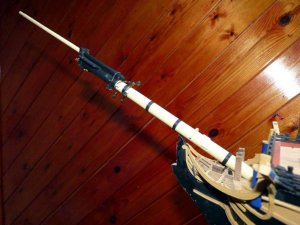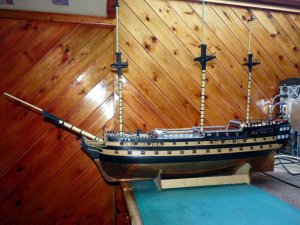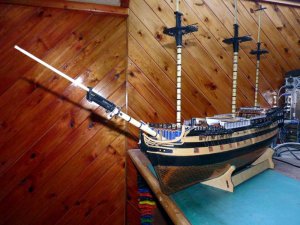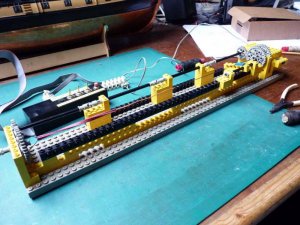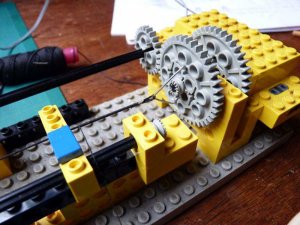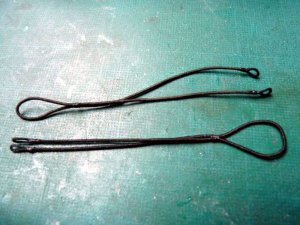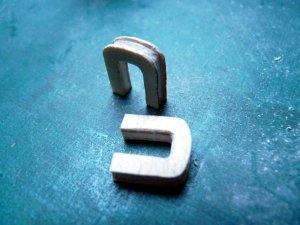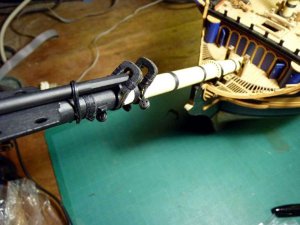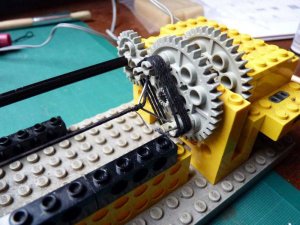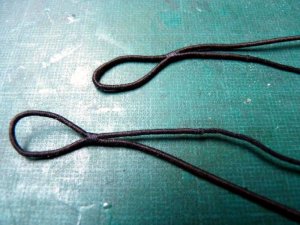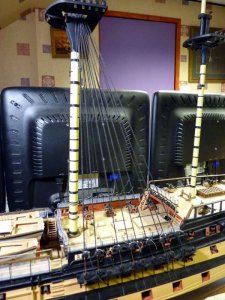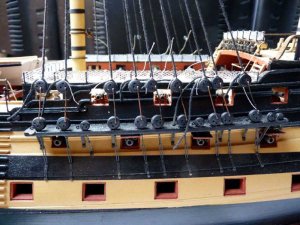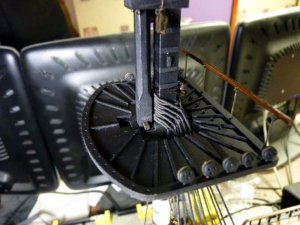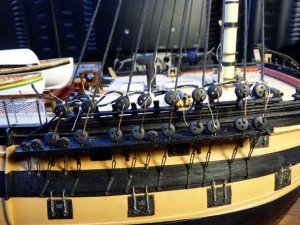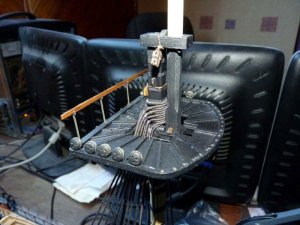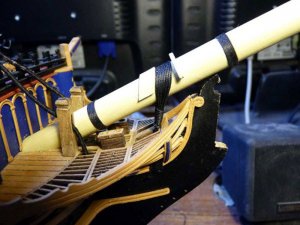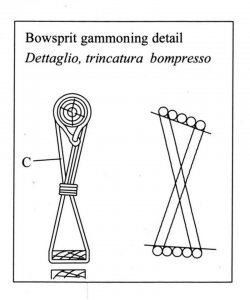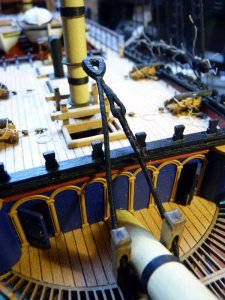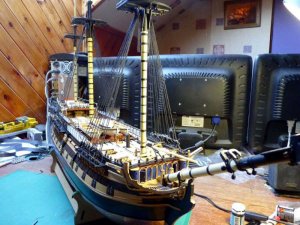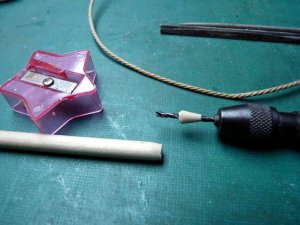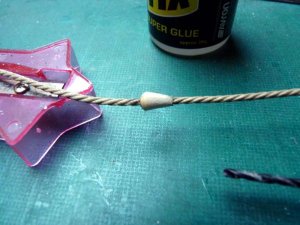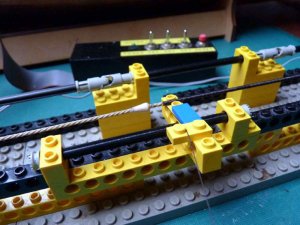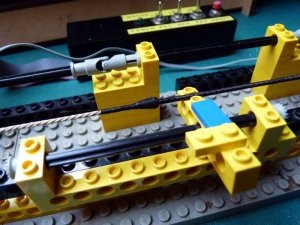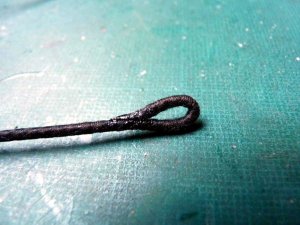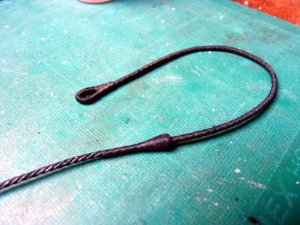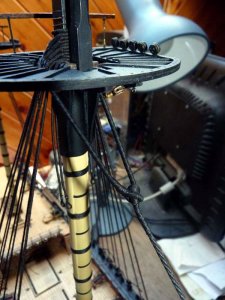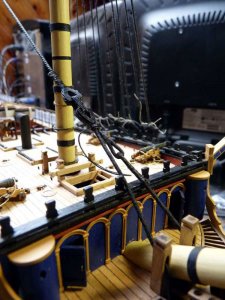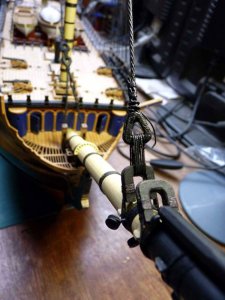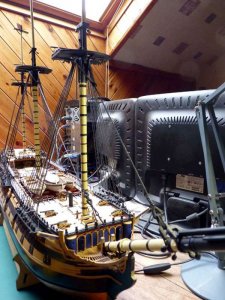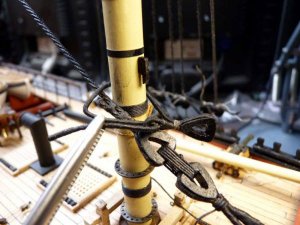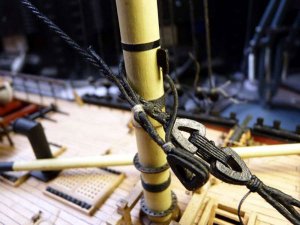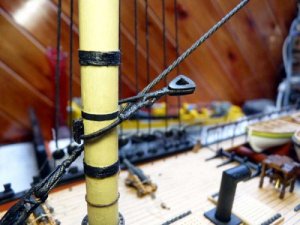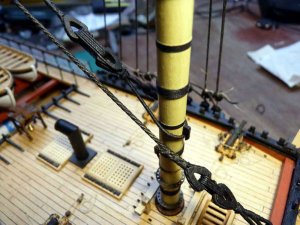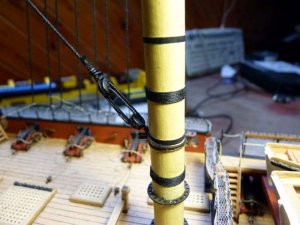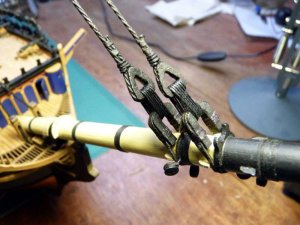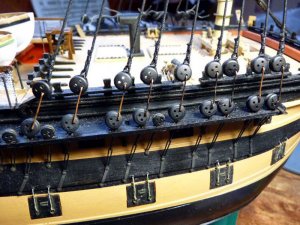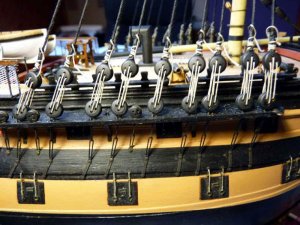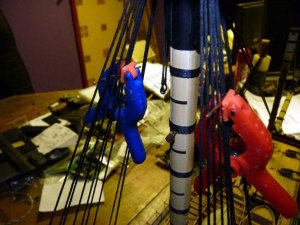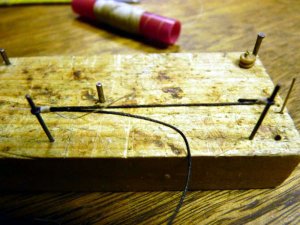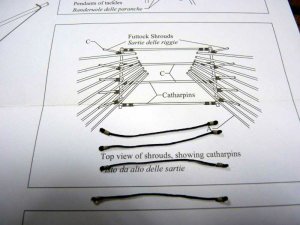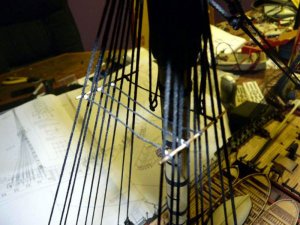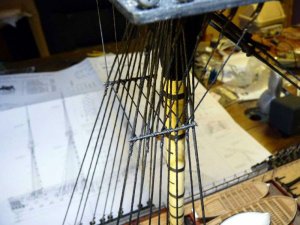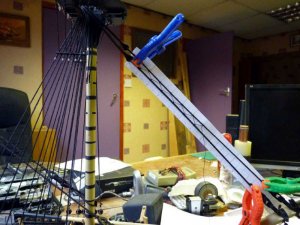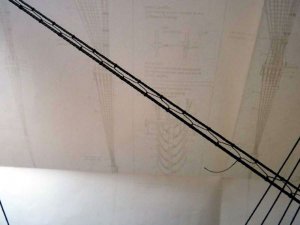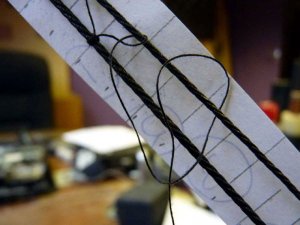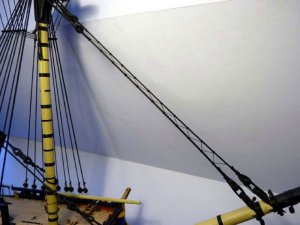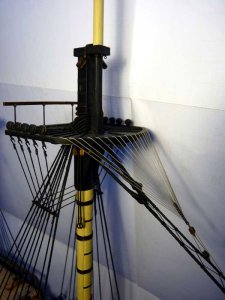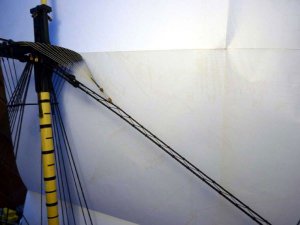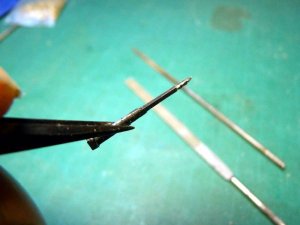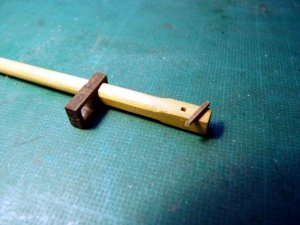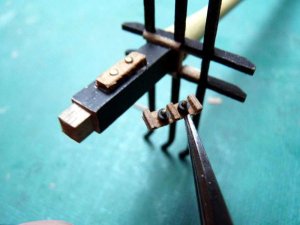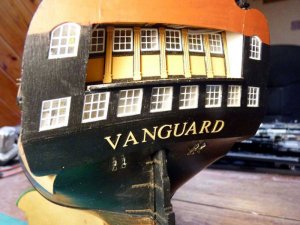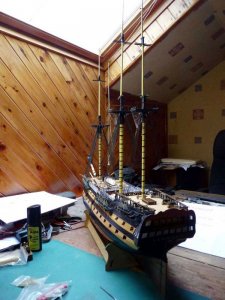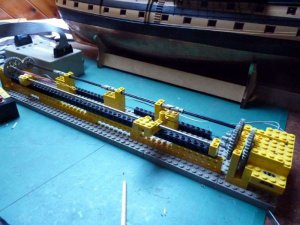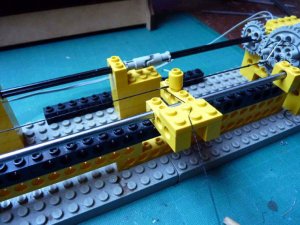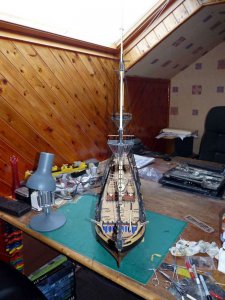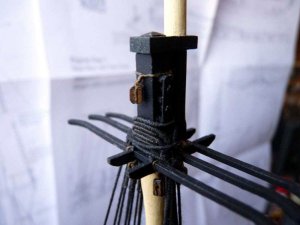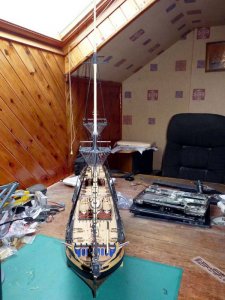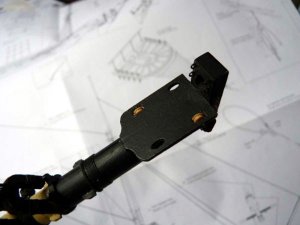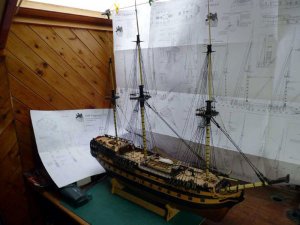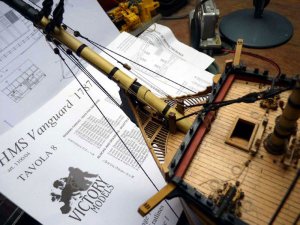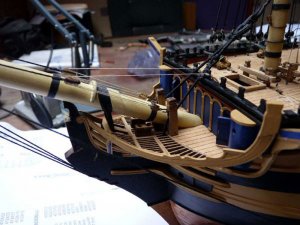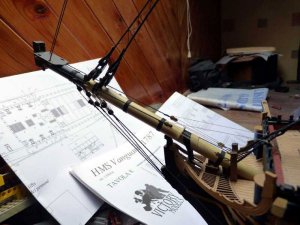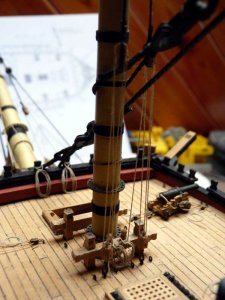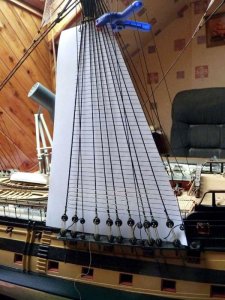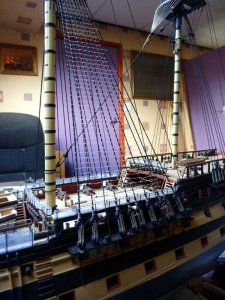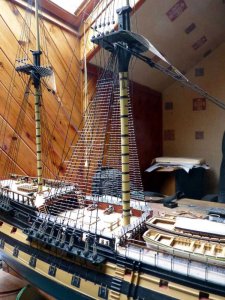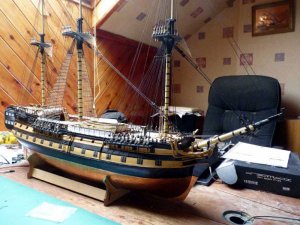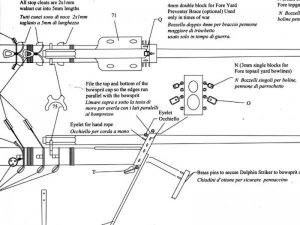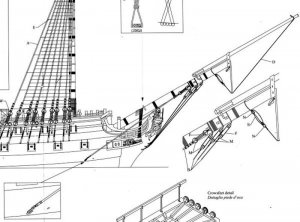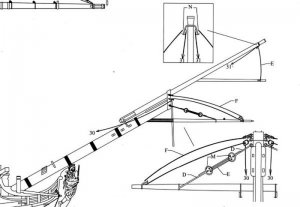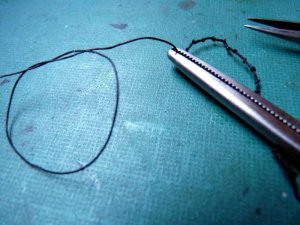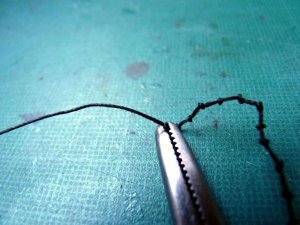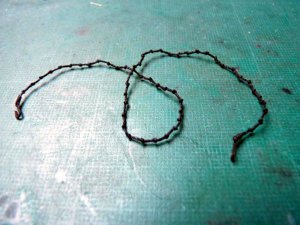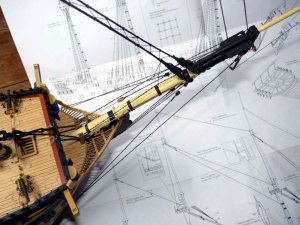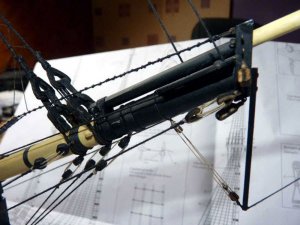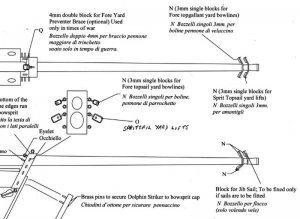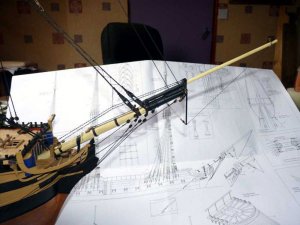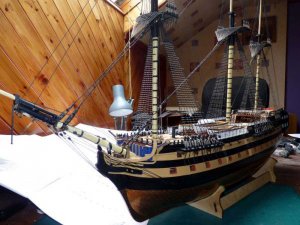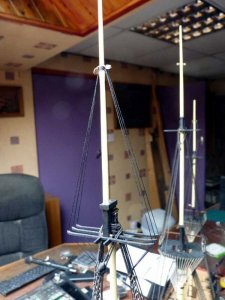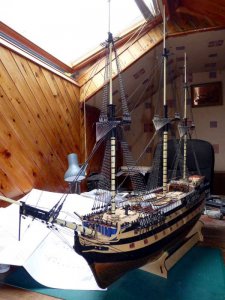At this point I decided to assemble the fore mast and the fore top. There were a few things that weren’t clear to me and needed resolving.
• I’d already seen posts saying that the fore mast cap, which is in two pieces, should have a square hole to fit the end of the fore mast rather than a round one.
• I couldn’t make sense of the cross sections of the mast.
• The top section of the mast is square but the diagram shows it to be larger than can be cut from a 10mm dowel.
• There are a number of blocks below the top but it wasn’t clear which were at the front and which at the back
• I didn’t understand the bottom of the fore top mast.
I decided to see what I could do with the cap. I managed to square up the hole to just under 6mm which was less than the dimension of the top of the mast so that seemed a viable solution.
I gave up on the cross section drawings and decided to see how it worked out.
I put the fore top and cross trees together. There’s a bit of play in the joints so I took advantage of this and put the fore and aft pieces as close together as possible. They ended up 8.2mm apart. That meant that when I planed down the sides of the mast, I had to end up at 8.2mm at the point where the cross trees fitted. At the lower end I took off half the thickness of the mast cheeks.
I was getting brave at this point so I glued the hounds to the cheeks and then clamped them to the mast. I could now dry fit the top in place and mark the upper edge of the cross trees.
With that done, I squared off the mast above this point. Theoretically the largest square I could make out of a 10mm dowel is just over 7mm. I opted to make it 7.5mm and accept very slightly rounded corners. At the same time I squared up the section that fitted between the cross trees by trimming the fore and aft sides to bring that down to 8.2mm.
I slightly chamfered the transition between the 8.2mm square section and the 7.5mm one.
The final job was to square up the top section to fit the hole in the cap.
This was my kit of parts at this time:
PICT_V_4101
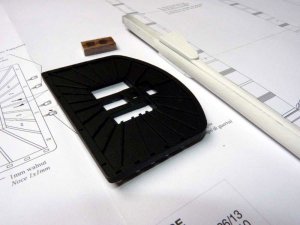
I should have taken a picture of the mast before I faired in the cheeks and gave it a coat of white primer.
The following pictures show how it fitted together:
PICT_V_4102
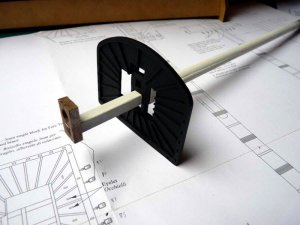
PICT_V_4103
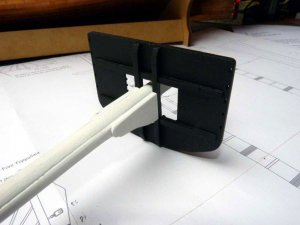
PICT_V_4104
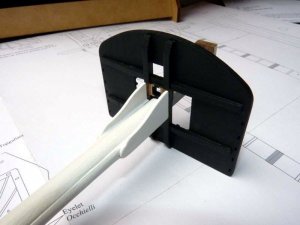
If you look at the top just in front of the mast, you’ll see I’ve framed the hole that takes the foot of the fore top mast. That mast is 7mm square at the bottom, smaller than the hole in the cross trees. It also has a 5mm long square section at the bottom which seems to be 5mm square. I’ve framed the hole to reduce it to 5mm, but I don’t understand this 5mm piece and think the hole should be 7mm. I thought it was easier to make it smaller at this stage and open it up if required than to frame and paint it later.
As far as the blocks are concerned, all seven of those shown under the top fit on the front cross piece but the outer three on each side are duplicated on the aft cross piece.
(For information those three carry lines 77, 78, 61,62 & 63 reading outwards from the mast.)
The two fiddle blocks shown above the mast are for the lifts and are strapped round the cap.
Note: The fore yard tie cleats seem to be incorrectly named. The fore yard tie goes over the cap at the same place as the two fiddle blocks; the lines above the cleats run to the jeer blocks.
Sorted!
Well, unfortunately not.
The fore topmast is shown as being 2mm from the fore mast, and at the bottom is spaced forward with a 2mm square walnut cross piece. The distance between the centres of the two sections of mast is about 9.2mm. When I dropped a drill bit through the front hole in the cap to see how it lined up, the answer was that it didn’t! It leaned forward quite a lot. When I checked the cap, I found the distance between centres to be 11.2mm.
I’ve now made a new cap!
Here’s how they compare.
PICT_V_4105
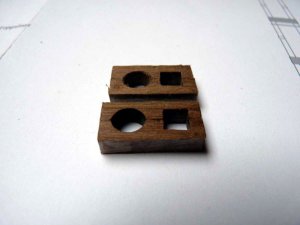
• I’d already seen posts saying that the fore mast cap, which is in two pieces, should have a square hole to fit the end of the fore mast rather than a round one.
• I couldn’t make sense of the cross sections of the mast.
• The top section of the mast is square but the diagram shows it to be larger than can be cut from a 10mm dowel.
• There are a number of blocks below the top but it wasn’t clear which were at the front and which at the back
• I didn’t understand the bottom of the fore top mast.
I decided to see what I could do with the cap. I managed to square up the hole to just under 6mm which was less than the dimension of the top of the mast so that seemed a viable solution.
I gave up on the cross section drawings and decided to see how it worked out.
I put the fore top and cross trees together. There’s a bit of play in the joints so I took advantage of this and put the fore and aft pieces as close together as possible. They ended up 8.2mm apart. That meant that when I planed down the sides of the mast, I had to end up at 8.2mm at the point where the cross trees fitted. At the lower end I took off half the thickness of the mast cheeks.
I was getting brave at this point so I glued the hounds to the cheeks and then clamped them to the mast. I could now dry fit the top in place and mark the upper edge of the cross trees.
With that done, I squared off the mast above this point. Theoretically the largest square I could make out of a 10mm dowel is just over 7mm. I opted to make it 7.5mm and accept very slightly rounded corners. At the same time I squared up the section that fitted between the cross trees by trimming the fore and aft sides to bring that down to 8.2mm.
I slightly chamfered the transition between the 8.2mm square section and the 7.5mm one.
The final job was to square up the top section to fit the hole in the cap.
This was my kit of parts at this time:
PICT_V_4101

I should have taken a picture of the mast before I faired in the cheeks and gave it a coat of white primer.
The following pictures show how it fitted together:
PICT_V_4102

PICT_V_4103

PICT_V_4104

If you look at the top just in front of the mast, you’ll see I’ve framed the hole that takes the foot of the fore top mast. That mast is 7mm square at the bottom, smaller than the hole in the cross trees. It also has a 5mm long square section at the bottom which seems to be 5mm square. I’ve framed the hole to reduce it to 5mm, but I don’t understand this 5mm piece and think the hole should be 7mm. I thought it was easier to make it smaller at this stage and open it up if required than to frame and paint it later.
As far as the blocks are concerned, all seven of those shown under the top fit on the front cross piece but the outer three on each side are duplicated on the aft cross piece.
(For information those three carry lines 77, 78, 61,62 & 63 reading outwards from the mast.)
The two fiddle blocks shown above the mast are for the lifts and are strapped round the cap.
Note: The fore yard tie cleats seem to be incorrectly named. The fore yard tie goes over the cap at the same place as the two fiddle blocks; the lines above the cleats run to the jeer blocks.
Sorted!
Well, unfortunately not.
The fore topmast is shown as being 2mm from the fore mast, and at the bottom is spaced forward with a 2mm square walnut cross piece. The distance between the centres of the two sections of mast is about 9.2mm. When I dropped a drill bit through the front hole in the cap to see how it lined up, the answer was that it didn’t! It leaned forward quite a lot. When I checked the cap, I found the distance between centres to be 11.2mm.
I’ve now made a new cap!
Here’s how they compare.
PICT_V_4105

Last edited:


